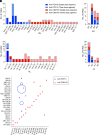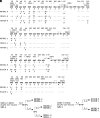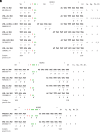Antigen-driven Convergent Evolution of Polysaccharide-specific "DH-less" B Cells in Glycoconjugate Immunized Mice
- PMID: 39093310
- PMCID: PMC11374756
- DOI: 10.4049/immunohorizons.2400055
Antigen-driven Convergent Evolution of Polysaccharide-specific "DH-less" B Cells in Glycoconjugate Immunized Mice
Abstract
Glycoconjugate vaccines elicit robust anti-polysaccharide Ab response by recruiting T-cell help. Multiple doses of glycoconjugate vaccine are required to induce long-lasting immunity. The characteristics of anti-polysaccharide Ab response have been reported previously. However, the effect of glycoconjugate booster immunization on anti-polysaccharide and anti-carrier protein Ab repertoire remains poorly understood. In this study, we used clinically relevant pneumococcal capsular polysaccharide type 14 (PCP14) conjugated with cross-reactive material 197 (CRM197) as a model glycoconjugate Ag (PCP14-CRM197). We performed a comprehensive sequence analysis of mouse mAbs generated against PCP14 and CRM197 following immunization with one or three doses of PCP14-CRM197. Analysis of the paired Ig H and L chain transcripts revealed that anti-PCP14 Ab repertoire is extremely restricted. The reoccurrence of five replacement mutations at identical positions in anti-polysaccharide mAbs generated from different mice provided evidence for Ag-driven selection in PCP14-specific B cells. Convergent evolution was observed wherein distinct V(D)J rearrangements resulted in identical or nearly identical CDR3 in anti-PCP14 mAbs. Abs that lacked DH encoded amino acids dominated the anti-PCP14 Ab response. In contrast, anti-CRM197 Ab response was quite diverse, with fewer mutations compared with the anti-PCP14 mAbs, suggesting that conjugation of the polysaccharide to a carrier protein interferes with the development of carrier protein-specific Ab responses. Our findings provide molecular insights into the maturation of Ab responses driven by booster doses of glycoconjugate. This has fundamental implications for the design of glycoconjugate vaccines, especially where the development of Ab response against the carrier protein is also crucial.
Copyright © 2024 The Authors.
Conflict of interest statement
The authors have no financial conflicts of interest.
Figures







Similar articles
-
Antibody- and cell-mediated immune responses to a synthetic oligosaccharide conjugate vaccine after booster immunization.Vaccine. 2011 Sep 2;29(38):6498-504. doi: 10.1016/j.vaccine.2011.07.013. Epub 2011 Jul 19. Vaccine. 2011. PMID: 21767596
-
Conjugation of PspA4Pro with Capsular Streptococcus pneumoniae Polysaccharide Serotype 14 Does Not Reduce the Induction of Cross-Reactive Antibodies.Clin Vaccine Immunol. 2017 Aug 4;24(8):e00118-17. doi: 10.1128/CVI.00118-17. Print 2017 Aug. Clin Vaccine Immunol. 2017. PMID: 28637805 Free PMC article.
-
A semisynthetic Streptococcus pneumoniae serotype 8 glycoconjugate vaccine.Sci Transl Med. 2017 Mar 8;9(380):eaaf5347. doi: 10.1126/scitranslmed.aaf5347. Sci Transl Med. 2017. PMID: 28275152 Free PMC article.
-
Experience with pneumococcal polysaccharide conjugate vaccine (conjugated to CRM197 carrier protein) in children and adults.Clin Microbiol Infect. 2013 Oct;19 Suppl 1:1-9. doi: 10.1111/1469-0691.12320. Clin Microbiol Infect. 2013. PMID: 24083785 Review.
-
Protective immunity of pneumococcal glycoconjugates.Crit Rev Microbiol. 2003;29(4):333-49. doi: 10.1080/713608018. Crit Rev Microbiol. 2003. PMID: 14636043 Review.
Cited by
-
Physicochemical properties, biological activities, applications, and protective potential of the skeletal system of Eucommia ulmoides polysaccharides: a review.Front Pharmacol. 2025 Mar 13;16:1570095. doi: 10.3389/fphar.2025.1570095. eCollection 2025. Front Pharmacol. 2025. PMID: 40183083 Free PMC article. Review.
References
-
- Rappuoli, R. 2018. Glycoconjugate vaccines: principles and mechanisms. Sci. Transl. Med. 10: eaat4615. - PubMed
-
- Weintraub, A. 2003. Immunology of bacterial polysaccharide antigens. Carbohydr. Res. 338: 2539–2547. - PubMed
-
- Mawas, F., Feavers I. M., Corbel M. J.. 2000. Serotype of Streptococcus pneumoniae capsular polysaccharide can modify the Th1/Th2 cytokine profile and IgG subclass response to pneumococal-CRM(197) conjugate vaccines in a murine model. Vaccine 19: 1159–1166. - PubMed
Publication types
MeSH terms
Substances
LinkOut - more resources
Full Text Sources

